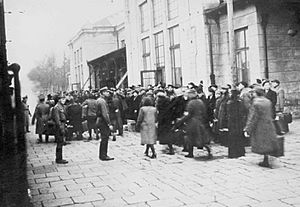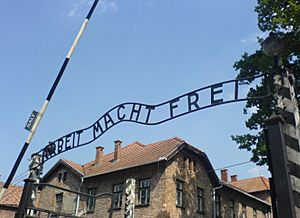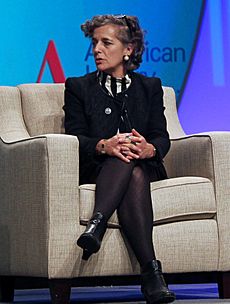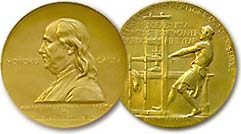Art Spiegelman facts for kids
Quick facts for kids Art Spiegelman |
|
|---|---|

Art Spiegelman in 2012
|
|
| Born | Itzhak Avraham ben Zeev Spiegelman February 15, 1948 Stockholm, Sweden |
| Nationality | American |
| Area(s) | Cartoonist, Editor |
|
Notable works
|
|
| Spouse(s) | Françoise Mouly (m. 1977) |
| Children |
|
Art Spiegelman (born February 15, 1948) is a famous American cartoonist and editor. He is best known for his powerful graphic novel called Maus. This book tells the story of his father, who survived the Holocaust.
Spiegelman also helped create popular trading card series like Wacky Packages and Garbage Pail Kids. He was a co-editor for important comics magazines, Arcade and Raw. For ten years, he was a contributing artist for The New Yorker magazine. In 2022, he received a special award for his important contributions to American literature.
Contents
Family History
Art Spiegelman's parents, Władysław (Vladek) and Andzia (Anja), were Polish Jews. They were born in Poland. The name Spiegelman means "mirror man" in German.
Before Art was born, his parents had another son named Rysio. During the Holocaust, his parents sent Rysio to stay with an aunt. Sadly, the aunt and Rysio died to avoid being taken by the Nazis. After the war, Art's parents searched for Rysio, hoping he was still alive. Art felt like he was competing with his "ghost brother." Out of 85 Spiegelman relatives alive before World War II, only 13 survived the Holocaust.
Life and Career
Early Life
Art Spiegelman was born in Stockholm, Sweden, on February 15, 1948. His family moved to the United States in 1951. They settled in New York City in 1957.
He started drawing cartoons in 1960. He loved comic books like Mad. By the time he was in high school, he was already earning money from his drawings. He even got an offer to create a syndicated comic strip. But he turned it down because he wanted to make art that expressed his own ideas.
After high school, his parents wanted him to choose a secure job. But Art decided to study art and philosophy at Harpur College. While there, he got a freelance job at Topps. Topps makes bubblegum and trading cards. This job supported him for the next twenty years. He helped create the funny Wacky Packages trading cards.
In 1966, Spiegelman started selling his own underground comix. These were independent comic books. He traveled to San Francisco in 1967, where the underground comics scene was growing. In 1968, he had a brief nervous breakdown, which caused him to leave college.
Underground Comics (1971–1977)
In 1971, Spiegelman moved to San Francisco. He became part of the countercultural underground comix movement. He created experimental and sometimes shocking comics. He was searching for his own unique artistic style.
In 1972, another cartoonist asked him to create a three-page comic about racism. Spiegelman decided to tell a story about the Holocaust. He showed Jews as mice and Nazis as cats. He called this short comic "Maus." He felt that with this story, he had found his true artistic voice.
As the underground comics movement slowed down, Spiegelman co-edited a magazine called Arcade. It aimed to show how comics connected to broader art and literature. In 1975, Spiegelman moved back to New York City.
He met Françoise Mouly, an architecture student from Paris. They became close friends. Spiegelman introduced Mouly to the world of comics. They got married in 1977. Mouly helped him put together a collection of his experimental comics called Breakdowns.
Raw and Maus (1978–1991)
Breakdowns did not sell well. This made Mouly want to control the printing process herself. She learned about printing and bought her own press. In 1980, she and Spiegelman started a new magazine called Raw. It featured new, experimental artists and introduced foreign cartoonists to English-speaking readers.
Spiegelman began interviewing his father again in 1978. He wanted to create a full-length book about his father's experiences in the Holocaust. He visited the Auschwitz concentration camp in 1979 for research. The book, Maus, was published chapter by chapter in Raw starting in 1980.
His father passed away in 1982. In 1986, the first part of Maus was published as a book. It was called Maus: A Survivor's Tale. The book became very popular. It was sold in regular bookstores, not just comic shops.
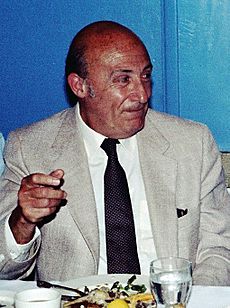
From 1978 to 1987, Spiegelman taught at the School of Visual Arts in New York. He taught alongside famous cartoonists like Harvey Kurtzman and Will Eisner.
In 1985, Spiegelman created the Garbage Pail Kids trading cards for Topps. These cards were funny and a bit gross. They became very popular with kids. Spiegelman felt that working for Topps gave him creative freedom. However, he later ended his relationship with Topps due to disagreements over his artwork.
The final chapter of Maus was published in 1991. The complete graphic novel, Maus, received a special Pulitzer Prize in 1992. It was the first graphic novel to win such a prestigious award. It also had an exhibition at New York's Museum of Modern Art.
The New Yorker and Public Legitimacy (1992–2001)
In 1992, Spiegelman started working for The New Yorker magazine. He worked there for ten years. He created 21 covers for the magazine. Some of his covers were very famous, like the Valentine's Day issue in 1993. It showed a Black woman and a Hasidic man kissing.
Spiegelman also wrote articles and comics for The New Yorker. He wrote about other cartoonists and artists. In 2001, he published a book about the cartoonist Jack Cole.
He also worked as a comics editor for other magazines. He helped publish "comics journalism" pieces. These were real-life stories told in comic book form. This helped make comics more respected as a way to tell serious stories.
In 1997, Spiegelman published his first children's book, Open Me...I'm a Dog. From 2000 to 2003, he and Mouly edited a children's comics anthology called Little Lit.
Post-September 11 (2001–present)
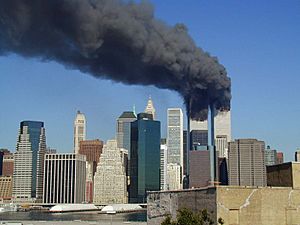
Spiegelman lived near the World Trade Center site in New York City. This area was called "Ground Zero" after the September 11 attacks in 2001. He and Mouly created a famous cover for The New Yorker after the attacks. It looked completely black at first. But if you looked closely, you could see the dark outlines of the World Trade Center towers.
Spiegelman left The New Yorker in 2003. He felt that the media had become too cautious after 9/11. He wanted to create art that was more challenging.
He responded to the September 11 attacks with a new work called In the Shadow of No Towers. It was first published in a German newspaper. The collected book came out in 2004.

In 2006, Spiegelman wrote an article about controversial cartoons for Harper's Magazine. He discussed how political cartoons can sometimes cause strong reactions.
To help children learn to read, Françoise Mouly started a line of easy-reader comics called Toon Books in 2008. Spiegelman's book Jack and the Box was one of the first.
In 2011, he released MetaMaus. This book was a deep look into the making of Maus. It included a DVD with extra materials.
In 2014, Spiegelman created a touring show called Wordless! It was about wordless novels, which are stories told only through pictures. In 2012, a big exhibition of his work called Art Spiegelman's Co-Mix: A Retrospective opened in France. It later traveled to other cities around the world.
Personal Life
Art Spiegelman married Françoise Mouly on July 12, 1977. They have two children: a daughter named Nadja Rachel (born in 1987) and a son named Dashiell Alan (born in 1992).
Style
Spiegelman has a "lazy eye," which means he doesn't see depth very well. He says this affects his art style. He believes comics are like "very condensed thought structures," similar to poetry. They require careful planning, even if they look simple.
He likes to experiment with how comics show time, space, and ideas. He uses both old and new tools for his work. Sometimes he draws on paper, and other times he uses a digital pen and computer.
Influences
Harvey Kurtzman has been Spiegelman's biggest influence. He also learned from other famous cartoonists like Will Eisner and Winsor McCay.
Spiegelman read about graphic artists who made "wordless novels" (stories told only with pictures). This inspired him to create his own long comic stories. He was also influenced by writers like Franz Kafka and filmmakers like Charlie Chaplin.
Beliefs
Spiegelman strongly believes that comics are an important art form. He thinks they help us understand information in a unique way. He has given lectures called "Comix 101" to teach people about the history and importance of comics. He also taught courses on comics at the School of Visual Arts. As an editor of Raw, he helped many younger cartoonists start their careers.
Spiegelman supports free speech. He believes people should be able to express their ideas freely. He has spoken out when he felt that media outlets were censoring cartoons.
He is not a religious person, but he identifies with Jewish culture.
Legacy
Maus is a very important work, not just for Art Spiegelman, but for the entire comics world. It helped make autobiographical comics popular. Many critics and academics have studied Maus. It is seen as a work that helped bring comics into the world of serious art.
Spiegelman's ideas about comics have influenced other cartoonists. His New Yorker cover about 9/11 was named one of the top magazine covers of the past 40 years. He has inspired many cartoonists to create their own graphic novels.
Several documentaries have been made about Art Spiegelman and his work, including Art Spiegelman's Maus and Serious Comics: Art Spiegelman. He even appeared as himself in an episode of The Simpsons.
Awards
- 1982: Yellow Kid Award, Italy
- 1987: Inkpot Award
- 1988: Angoulême International Comics Festival, Prize for Best Comic Book, for Maus
- 1990: Max & Moritz Prize, Germany, Special Prize, for Maus
- 1992: Pulitzer Prize, for Maus
- 1992: Eisner Award, Best Graphic Album (reprint), for Maus
- 1992: Harvey Award, Best Graphic Album of Previously Published Work, for Maus
- 1993: Angoulême International Comics Festival, Prize for Best Comic Book, for Maus II
- 1995: Binghamton University, honorary Doctorate of Letters
- 1999: Eisner Award, inducted into the Hall of Fame
- 2005: Chevalier of the Ordre des Arts et des Lettres (from the French government)
- 2005: Time magazine, one of the "Top 100 Most Influential People"
- 2011: Angoulême International Comics Festival, Grand Prix
- 2011: National Jewish Book Award for MetaMaus
- 2015: American Academy of Arts and Letters membership
- 2018: The Edward MacDowell Medal
See also
 In Spanish: Art Spiegelman para niños
In Spanish: Art Spiegelman para niños


